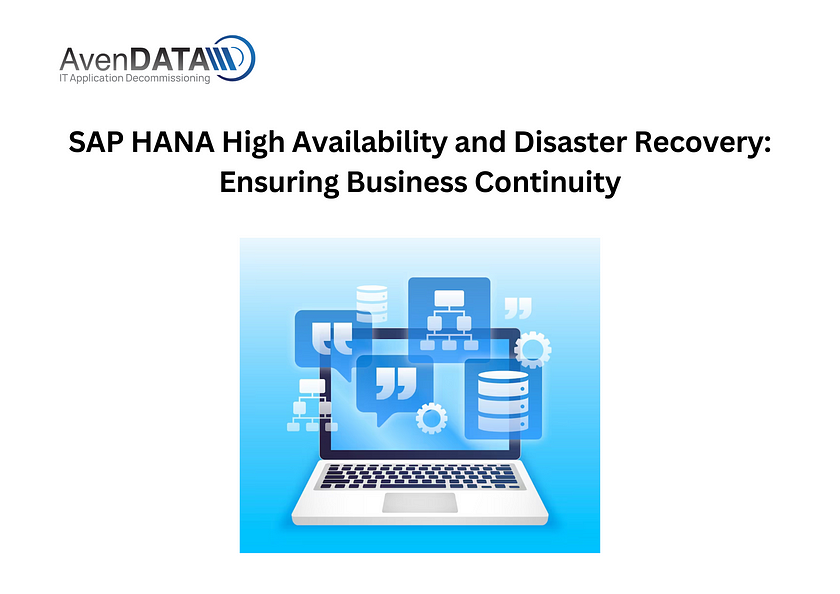Introduction: In today’s data-driven business landscape, organizations rely heavily on their SAP HANA environments to run critical applications and support key business operations. To ensure uninterrupted availability and protect against potential disasters, organizations must implement robust high availability (HA) and disaster recovery (DR) strategies. This blog explores the importance of SAP HANA HA and DR, highlighting key considerations, best practices, and technologies that enable organizations to ensure business continuity and minimize downtime.
High Availability (HA) for SAP HANA: High availability refers to the ability of a system or application to remain accessible and operational even in the event of hardware or software failures. SAP HANA HA ensures that organizations can continue to access and utilize data without disruption. Implementing HA for SAP HANA involves redundant hardware, storage, and network configurations, as well as automated failover mechanisms that quickly switch to backup systems in the event of a failure.
Disaster Recovery (DR) for SAP HANA: Disaster recovery focuses on data protection and the ability to restore operations following a catastrophic event. SAP HANA DR strategies involve replicating and maintaining copies of data in a separate location, often a remote data center. In the event of a disaster, organizations can quickly recover and restore data, applications, and systems to resume operations. DR plans include regular backups, data replication, and well-defined recovery time objectives (RTO) and recovery point objectives (RPO).
Replication Technologies: To ensure data consistency and minimize data loss in HA and DR scenarios, organizations can leverage various replication technologies provided by SAP HANA. Asynchronous and synchronous replication options allow for real-time or near-real-time data synchronization between primary and backup systems. These technologies enable organizations to maintain data integrity and ensure that any changes made in the primary system are replicated to the backup system seamlessly.
System Monitoring and Health Checks: Regular monitoring and health checks are crucial for maintaining the effectiveness of SAP HANA HA and DR systems. Organizations should implement monitoring tools and processes to track system performance, resource utilization, and replication status. Proactive monitoring allows organizations to identify any potential issues or bottlenecks, address them promptly, and maintain a high level of system availability.
Regular Testing and Simulation: Regular testing and simulation of HA and DR scenarios are essential to validate the effectiveness of the implemented strategies. Organizations should conduct planned failover and failback tests to ensure that the backup systems can seamlessly take over operations and that data is recovered successfully. Regular testing helps identify any gaps or issues in the HA and DR setup and allows for necessary adjustments to be made.
Documentation and Communication: Having clear and up-to-date documentation of HA and DR procedures is vital. This includes documenting step-by-step instructions for failover, failback, and recovery processes, as well as contact information for key personnel involved in the response. Effective communication plans should also be in place to ensure that all stakeholders are informed during a disaster and that the necessary actions are taken promptly to minimize downtime and data loss.
Continuous Improvement and Updates: SAP HANA HA and DR strategies should be regularly reviewed and updated to align with evolving business requirements and technological advancements. Organizations should stay informed about the latest SAP HANA features, updates, and best practices related to HA and DR. By continuously improving and updating their HA and DR plans, organizations can ensure that they are well-prepared to handle any potential disruptions and maintain business continuity.
Conclusion: Implementing high availability and disaster recovery strategies for SAP HANA is essential for ensuring business continuity and minimizing downtime. By leveraging replication technologies, conducting regular testing, implementing effective monitoring and documentation practices, and continuously improving the HA and DR plans, organizations can safeguard their critical SAP HANA environments. With robust HA and DR measures in place, organizations can confidently rely on SAP HANA to support their operations, protect valuable data assets, and ensure uninterrupted availability even in the face of unexpected events.
#AvenDATA #legacydata #SAPHana #SAPSystems #SAParchiving #dataarchiving







